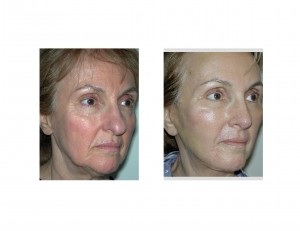Skin resurfacing is a very useful facial rejuvenation procedure that brightens one’s complexion and helps reduce or eliminate the appearance of fine wrinkles. Once done exclusively by chemical peels, the introduction and evolution of laser technologies have pushed the use of topical chemicals to the background. Most people recognize laser treatments such as CO2 and fractional as the most cutting edge skin resurfacing approaches.
While laser skin treatments can provide some significant skin improvements, they are not without their downsides. They are expensive, in the range of thousands of dollars per full face treatment, and have significant social recovery. Such shortcomings make them not ideal for many patients.
Chemical peeling may be old, dating back thousands of years, but it has a long history of successful results. Phenol is the most aggressive facial peel and was the gold standard for a deep result. But its use required a lot of experience and expertise to avoid problems such as tissue burns, loss of skin pigment, and cardiac reactions and toxicity. The replacement of chemical peels with the laser was spurned by a method of skin resurfacing that was more controllable and posed less systemic risks.
Lost in this shuffle has been the trichloroacetic acid (TCA) peel.. This peel, while not as deep, is much safer and predictable than that of phenol. It is a very versatile peel, being available in concentrations from 10% to 70% , which produces different depths of penetration and results. TCA exerts its action by the almost immediate coagulation of dermal proteins, which produces a classic white frost as the coagulation proceeds because of temporary blood vessel constriction.
TCA peeling can be safely used on all skin types, unlike laser resurfacing. However, it is not without some risk of pigment changes. Therefore, darker skin types in the Fitzpatrick four to six classification should be done only with lower TCA peel concentrations and with the use of before and after hyperpigmentation topical treatments.
One of the big advantages to TCA peels is the various concentrations available for different amounts of results and associated recoveries. As a general rule, the higher the concentration of TCA the deeper the peel, the better the results, and the longer the facial recovery.

Applying more costs of 15% TCA increases the depth of the epidermal damage and will increase healing up to around five or six days. This use of 15% TCA improves the results and helps reduce the finest lines and wrinkles.

While higher concentrations do exist and can be used (e.g., 70% TCA), their risks of skin problems rival that of the laser. If one is seeking this depth of skin penetration, the laser is more predictable and safer in my opinion.
Despite the avalanche of available laser technologies for skin rejuvenation, The TCA peel remains an economical and safe treatment that can be done in conjunction with facial plastic surgery procedures or as a stand alone skin treatment. Its ability to be used in different skin types safely and predictably is another valuable advantage.
Dr. Barry Eppley
Indianapolis, Indiana


